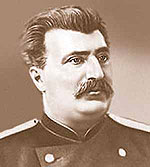 |
Local residents from the windows of their adobe dwellings watched the people passing by travelers... And they walked in silence, to their route among the hostile and restless local population. From time to time, people came to the travelers: in hundreds they knelt on both sides of the road, there were seriously ill people who came to ask for healing, old and young - everyone wanted to receive the blessings of the great white kubilgan (saint), that is what they called Przhevalsky... As if the steppe wind was blowing across Central Asia extraordinary rumors and myths about Przhevalsky and his companions: the Russian chief is a sorcerer or a saint, he needs to pray, because he knows everything in advance. Fortunate destiny ... made it possible to carry out feasible exploration of the least known and most inaccessible countries of inner Asia. |
Indeed, the famous Russian travel geographer Nikolai Mikhailovich Przhevalsky had an amazing fate, did he know, as a little rural boy, that such an extraordinary life, full of adventures and the greatest discoveries, awaits him?
Was born N.M. Przhevalsky April 12, 1839 in the village of Kimbory, Smolensk province in the family of a small landowner. Since childhood, he was fascinated by the mysterious natural world, the boy's favorite pastime was reading books about travel and animals... Being an idealist, at the age of 16, he decides to enlist in the Belevsky regiment, but military affairs did not meet the expectations of the young seeker: the endless revelry and licentiousness of the officers turned his views on life and humanity. All his free time from the service he is engaged in hunting, ornithology, collects herbariums. After five years in the regiment, Przhevalsky enters the Academy of the General Staff, the completion of which would give him the opportunity to finally do what he loves - travel... Having entered his studies, Przhevalsky is more and more engaged in creativity than in military affairs, his course work "Military Statistical Review of the Amur Territory" brings him membership in the Russian Geographical Society. This was the first step towards the life he dreamed of.
After graduation from the Academy Przhevalsky teaches at the Warsaw cadet school, while doing science, writes a textbook on general geography for cadets. Africa at that time interested him most of all. However, he soon begins to be attracted central Asia: “I am confident that sooner or later, I will fulfill my cherished dream of travel- writes N.M. Przhevalsky- he intensively studied botany, zoology, physical geography, etc., and in the summer he went to his village, where he continued the same occupations, collected herbarium "1
 |
In 1867 Przhevalsky appeals to the Russian Geographical Society with a request to help in organizing an expedition to Central Asia, but, having no name in scientific circles, he, unfortunately, could not count on the support of the Council of the Society, which rejected his request. On the advice of P.P. Semyonov - Tyan-Shansky he decides to go to the Ussuri region, in the hope of earning upon his return the long-awaited opportunity to gather an expedition in Central Asia... The result of the two-year trip was the essays "On the non-Russian population in the southern part of the Amur Region" and " Journey in the Ussuri region ", as well as about 300 species of plants, birds, and many of them were discovered on the Ussuri for the first time. For the work done, the Russian Geographical Society awarded Przhevalsky with a silver medal, but the main award for the born explorer was the approval and help of the Geographical Society in organizing his next trip - already in Central Asia. |
First trip to Central Asia (1870 - 1873), called "Mongolian" turned out to be extremely difficult and dangerous. The members of the expedition covered more than 11,000 km in total. through Moscow, Irkutsk, Kyakhta, Beijing and north to Lake Dalai-Nur.
|
After resting in Kalgan, Przhevalsky explored the Suma-Hody and Yin-Shan ridges, as well as the course of the Yellow River (Yellow River), showing that it has no ramification, as was previously thought on the basis of Chinese sources; passing through the Alashan and Alashan desert the mountains, he returned to Kalgan. On March 5, 1872, the expedition again set out from Kalgan and moved through the Alashan Desert to the Nanshan ridges and further to Lake Kukunor. Then Przhevalsky crossed the Tsaidam Basin, overcame the Kunlun ridges and reached in Tibet upper reaches of the Blue River (Yangtze). In the summer of 1873 Przhevalsky, having replenished his equipment, went to Urga (Ulan Batoru), through the Middle Gobi, and from Urga in September 1873 returned to Kyakhta. Three years of the most difficult physical tests and as a result - 4000 specimens of plants, new species were discovered, which received his name: Przewalski's lizard, Przewalski's clefttail, Przewalski's rhododendron... This trip brought Nikolai Mikhailovich world fame and the gold medal of the Russian Geographical Society. As a report on your travel Przewalski writes the book "Mongolia and the country of the Tanguts". |
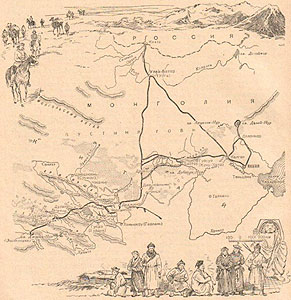 PRZEWALSKY'S FIRST JOURNEY |
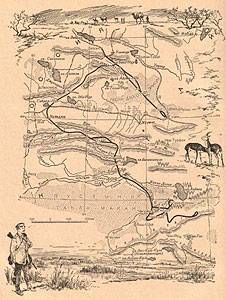 SECOND JOURNEY OF PRZHEVALSKY |
Its second Central Asian trip Nikolay Mikhailovich Przhevalsky begins in 1876. It was conceived very large-scale, it was supposed to investigate Tibet and Lhasa, but due to the complication of the political situation (the conflict with China) and the illness of Przewalski himself, the route had to be shortened. Starting his way from Gulja, overcoming Tien Shan ridges and the Tarim Basin Przhevalsky reached in February 1877 the huge reed swamp-lake Lop Nor. According to his description, the lake was 100 kilometers long and 20 to 22 kilometers wide. On the banks of the mysterious Lobnor, in the "land of Lop", Przhevalsky was second ... after Marco Polo! No obstacles prevented the researchers from making their discoveries: the lower reaches of the Tarim with a group of lakes and the Altyn-Tag ridge were described, materials were collected on the ethnography of the Lobnors (Karakurchins). After some time, an entry appears in Nikolai Mikhailovich's diary: “A year will pass, misunderstandings with China will be settled, my health will recover, and then I will again take the wanderer's staff and again head to the Asian deserts” 2 |
|
Third Central Asian Journey named "Tibetan" Przhevalsky performs in 1879 - 1880 with a detachment of 13 people. The path lay through the Khamian desert and Nan Shan ridge on the plateau Tibet. This expedition turned out to be surprisingly rich in discoveries. Its participants explored the Huang-He River, the northern part Tibet, two ridges are open, named Przhevalsky in honor of Humboldt and Ritter, a pik-eater bear, as well as a wild Dzungarian horse, which received the name in scientific literature "Przewalski's Horses": “The newly discovered horse,” writes Nikolai Mikhailovich, is called the Kirgiz kertag, and the Mongols also, lives only in the wildest parts of the Dzungarian desert. Here the kertags are kept in small herds grazing under the supervision of an experienced old stallion "3 Having received after that travels several honorary titles and titles and many acknowledgments and degrees, Przhevalsky, perhaps because of his natural modesty and rejection of the noisy bustling city life, retires in the village, where he begins to process the collected material. My observations and research results Przhevalsky outlined in the book "From Zaisana across Hami v Tibet and to the headwaters of the Yellow River ". |
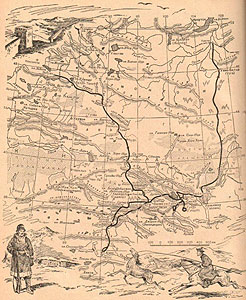 PRZEWALSKY'S THIRD JOURNEY |
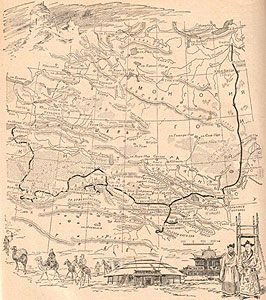 PRZEWALSKY'S FOURTH JOURNEY |
Fourth Central Asian Expedition was also known as the Second tibetan travel”And lasted from 1883 to 1885. And again Tibet! The Khuang-Khe River, dotted with key lakes, shining brightly in the rays of the setting sun, the marshy Yellow River, the sands of Alashan and Tarim; and new adventure and discovery: Orin-Nur, Dzharin-Nur lakes, Moskovsky and Russian ridges, Columbus ridge, the sources of the Yellow River were explored. New species of birds, mammals and reptiles, as well as fish have appeared in the collection, new species of plants have appeared in the herbarium. The result of this travels becomes the next book, written in the quietness of the Sloboda estate, "From Kyakhta to the sources of the Yellow River, exploration of the northern outskirts Tibet and the way through the Lob-nor along the Tarim basin ”. For those who knew the character of the indefatigable Nikolai Mikhailovich, it was not surprising that in his incomplete 50 years he decides to go to his fifth journey through Central Asia , which, alas, became the last for an outstanding scientist and researcher. |
Before leaving, Nikolai Mikhailovich went out onto the terrace of his estate and wrote in red pencil on one of the columns: “August 5, 1888 Goodbye, Sloboda! N. Przhevalsky ". Then he called his companions and asked them all to sign: V. Roborovsky, P. Kozlov, Teleshev, Nefedov.
On August 18, Nikolai Mikhailovich, accompanied by his closest friends, left Petersburg for the last time. As soon as the train started, he shouted through the open window of F.D. Pleske, birdwatcher: "If I am gone, I entrust you with handling the birds!"
On the train Przhevalsky continued to speak prophetic words, as if anticipating imminent death: “We are going to free, pleasant, glorious work. Now we are well armed and our life will not come cheaply: to die for a glorious cause is a pleasure. "
This time the path ran along the Volga, the Caspian Sea to Krasnovodsk (now Turkmenbashy?), From there to Samarkand and Pishpek (Bishkek). From Pishpek to Alma-Ata. On the way to the Russian-Chinese border, while hunting in the valley of the Kara-Balta river, Przhevalsky being already slightly cold, he drank river water and contracted typhoid fever.
In the last days of his life, Nikolai Mikhailovich behaved surprisingly courageously, did not lose heart, and openly, consciously spoke of death as an old acquaintance: "I am not afraid of death, - I am ready to die, I have been face to face with death more than once ..."
Having made several orders about his property, he bequeathed to bury himself on the shore Issyk-Kul.
October 20, 1888 great the traveler and a talented naturalist scientist Nikolai Mikhailovich Przhevalsky was gone. So his ashes remained forever in Asia, about which he dreamed all his life. In 1889, a monument was erected at his grave. On a block of granite stands a bronze eagle with an olive branch in its beak, ready to plunge into the sky, as a symbol of the glory and greatness of an indefatigable brave explorer who has always walked forward to his dream, who has become an example for many, many generations of scientists and travelers Worldwide.
Article prepared by SVETLANA SHCHEGLOVA
- The great Russian traveler Nikolai Mikhailovich Przhevalsky, Book Publishing House, 1948.
- Wikipedia




